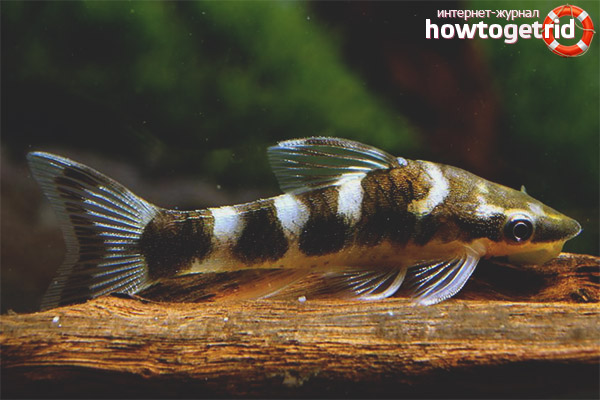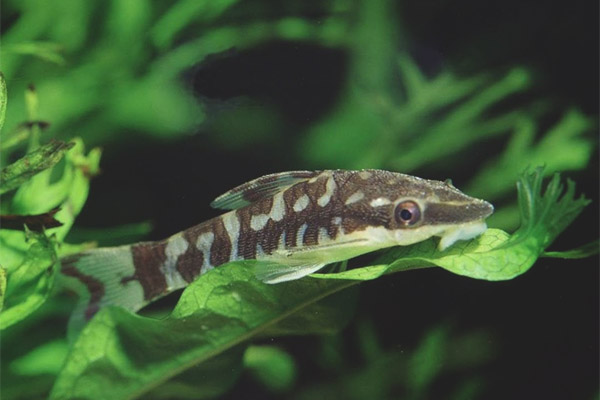The content of the article
The presence of fish-cleaners is an excellent solution for all owners of home aquariums with densely flowering vegetation. This is due to their effective help in improving the environment intended for the various inhabitants of the aquarium and maintaining the necessary internal balance.
The most popular, popular and clearly distinguished among other species of fish-cleaners is otozinclus, the features and rules of the content of which will be discussed in this material.
Description
Such an aquarium resident as a catfish ototsinklyus is a hardworking assistant to the owner of the aquarium and belongs to the kind of quite popular and well-known river inhabitants - chained catfish.A characteristic external difference from other species is the presence of accrete bone plates on a small and fragile body.
Natural habitat - waters of South America. Ototsinklyus - peaceful fish, quietly get along with all its neighbors, in the diet is dominated by vegetable food. It prefers reservoirs with clear water and moderate current, living in places with a more densely overgrown algae bottom, closer to the shore.
Small flocks of fish, the average size of which reaches 5 cm, regularly comb through the sandy bottom of the reservoir. Due to the presence of the mouth of the sucker, catfish can withstand even a fairly strong flow, firmly attached to the surface. Also, the features of the structure of the mouth allow this river dweller to clean the plants, while not violating their integrity.
Kinds
Currently, at least 17 species of aquarium fish related to the genus of otozinclus are known; their main differences are patterns on the body and tail. Nevertheless, not all of them are effective in the struggle for the purity of the aquarium, and not all of them can be contained in it.
The most well-known such subspecies of catfish cleaner as are: negros, affinis, and speckled otozinclus.
Most members of the somik otozinclus species are relatively small. Sometimes, due to their invisibility, this type of fish is quite difficult to detect in an aquarium. The size of the largest individuals reaches 5.5 cm, the smallest - a little more than two centimeters.
Features care and maintenance somikov cleaners
I would like to note that for the maintenance of these fish cleaners do not need a lot of water, for one small beak it will be quite enough, and 50 liters. It is important to understand that otsinklyusy - it is a very clean fish. Therefore, in order to keep the water in the aquarium constantly fresh, it should be equipped with special equipment (additional filter and aerator). As a rule, water is changed in aquariums with catfish cleaners weekly (at least 30% of the total). The most acceptable for this type of fish water temperature indicators vary in the range: 22-25 ° C, hardness parameters: 2-15 °.
It is important to consider that one of the most important conditions for keeping fish of this species is the presence of dense vegetation in an aquarium. This is explained by the fact that it is this “green” that is the main food for the catfish cleaner.
Unlike other fish - bright sunlight does not interfere with the otsinkly, in addition, this is a significant plus, as it improves the growth of aquarium plants.
As a rule, the main habitat of the fish is the bottom of the aquarium, however, they often rise to the top for a breath of fresh air, and this phenomenon is considered quite normal. This can be explained by the fact that in addition to gill respiration, catfish also have the so-called "intestinal", which is used only in case of emergency.
Feeding fish: what to consider

The presence of dense vegetation in the aquarium is enough to feed ottsinklus (accumulating plaque on the leaves of plants). However, it is necessary to monitor the activity of the flock of sweepers - the rapid targeting of cleanliness often subsequently forces the fish to starve. Therefore, feeding somikov cleaners required.These fish prefer a variety of dry food, as well as frozen food. Quite often experienced aquarists use lettuce leaves, green peas and cucumbers for more nutritious feeding of these small and brisk sweepers.
Some fans of otsinklyusov for better feeding their aquarium pets engaged in artificial cultivation of algae. To do this, you need to take a few pebbles from the aquarium and put them on the window sill. After some time, they will raid, which is the main delicacy of a small neat.
Compatibility - who do catfish cleaners get along with?
Ototsinklyus is quite a peace-loving and timid fish, from which you should not wait for the manifestations of aggression. Such peaceful nature and small size make catfish a target for most of the more aggressive neighbors. Therefore, somics in no case should not sit down to the fish of the genus Cichilus. But cohabitation with other cleaners (Siamese catfish) can create the most genuine food competition.
Aquarian inhabitants with whom ottsinklyus gets on very well, is:
- guppies;
- Werner's iriaterines;
- rodostomuses;
- neons;
- erythrozone;
- shrimp riley.
What fish are sick
The peculiarity of the catfish ottsinklyus in its excellent adaptation to new conditions, because of what they practically do not get sick. The main diseases that affect these small catfish include a variety of bacterial infections arising from the high levels of nitrates in the water.
Breeding and reproduction
Note that often the process of reproduction of otozincluses occurs almost imperceptibly, especially if the owner of the aquarium takes care of the presence of a large amount of greenery in it. Changes are noticeable only after the number of fish of this species increases markedly. Fry grow quite quickly - after 2-3 weeks, a small catfish cleaner reaches the size of an adult.
Caviar laying, as a rule, is performed several times over the summer, while an additional increase in the replacement of water volumes is not required.
To stimulate spawning, it is enough for owners of catfish cleaners to increase the feeding of protein (bloodworms, tubule and microorganisms that appear when water blooms).
Spawning features
The ideal place for breeding catfish cleaners of this type is a small aquarium (50-60 l.), Without additional soil and with the obligatory presence of a sponge filter. To feed the future offspring in the aquarium, you can plant Javanese moss and other plants. For spawning, it is enough to plant one female and several males, which immediately after spawning are deposited in a common aquarium. Water change is carried out once a week (at least 25-30% of the total).
During one spawning, the female lays at least 50-60 transparent yellowish eggs. If the caviar was laid in the general aquarium, then it can be carefully moved to the aquarium incubator, after cutting off the leaves of the plants, on which it stuck.
Fry from otsinklyus
When growing fry, one should not forget about regular and more frequent, than always, water changes in the aquarium used as an incubator. This will help to make a more efficient cleaning of the bottom of the remnants of feed, as well as significantly reduce the level of nitrates.
Important! During water changes, a special protective cap is put on the hose, which will prevent sucking of the fry.
As a feed for fry, you can use blooming water saturated with microorganisms. For these purposes, prepare a separate tank with aquarium water, which must be installed under direct sunlight.
Video: aquarium fish ototsinklyus












To send